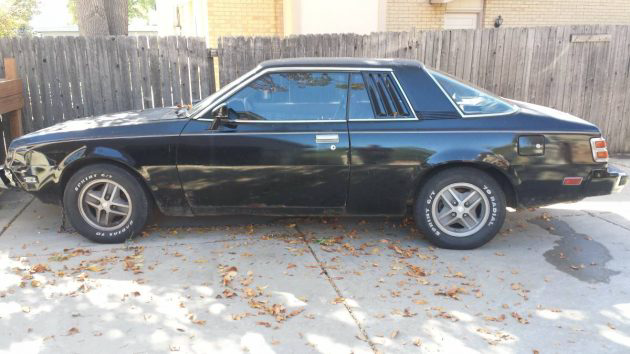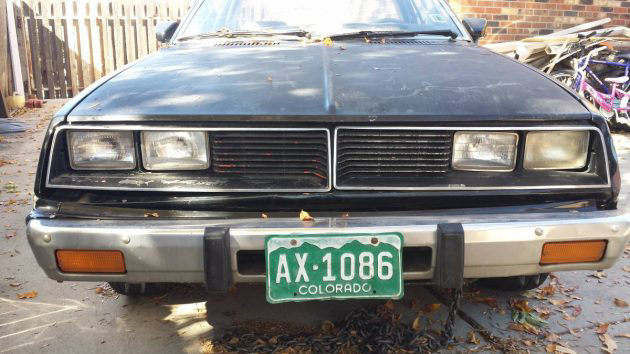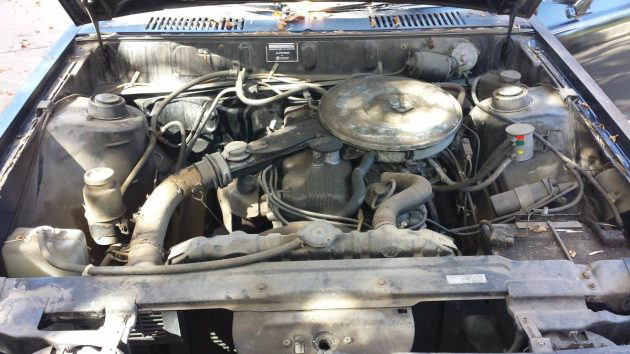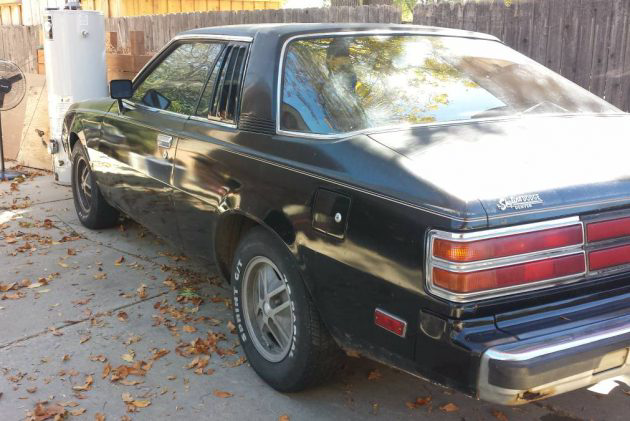Yes, It’s True: 1979 Dodge Challenger
Mitsubishi Motors has produced some legendary cars, with names rolling off of enthusiasts’ tongues like Eclipse, Evolution, VR-4, Montero, and…Dodge Challenger? Yes, from 1978 to 1983 a version of Mitsubishi’s Galant Lambda coupe was sold in the U.S. as the Dodge Challenger, positioned as a sportier twin to the Plymouth Sapporo that is probably better remembered today because it didn’t share a name with legendary muscle cars that it couldn’t possibly live up to. Still, in many ways this Challenger was the right car for struggling Chrysler at the turn of the ’80s, and it helped Mitsubishi establish its reputation as it prepared to enter the U.S. market under its own name. The seller of this ’79 has a sense of humor about it, which should help with any “That’s a Challenger?!?” inquiries; it’s here on craigslist in the Denver metropolitan area with an $800 ask (archived ad). Thanks to Paul C. for the find!
The ad is titled “1979 Dodge Challenger (yes it’s true),” and continues, “This isn’t a 1970 or even a Hemi” but it “would look good next to your 1970…[or] 2016…Challenger, Hellcat, SRT…as a conversational piece.” I’ll leave that up to you to decide, but will point out that with up to 35 EPA-rated highway miles per gallon, plus an import car look and feel that would be familiar to those cross-shopping Celicas, Accords, and Sciroccos, this Challenger made more sense for 1979 than a big Hemi coupe would have. It helped Chrysler meet its corporate average fuel efficiency (CAFE) standards and, let’s face it, all cash-strapped Chrysler would probably have been able to do to make its own Challenger at the time would have to have been heavily Aspen-based.
Plus, it might not be a Hemi…but how would you like an MCA-Jet? Fitted to the optional 2.6-liter four, the MCA-Jet system incorporated a valve that introduced additional air to the combustion chamber for more efficiency and power; this was also advertised as a “Silent Shaft” engine, touting the balance shafts that helped quell the noise and vibration inherent to a large four cylinder. We don’t know whether this is the 2.6 or the standard 1.6-liter engine. We do know that the seller was able to start it by feeding gas directly into the carburetor, but the car isn’t currently road-ready.
The Challenger and Sapporo were well-equipped cars for their $6,000 price point. Here we can see the five-speed stick, the remote trunk release, and the multi-adjustable driver’s seat, including lumbar support. It’s dirty, and there’s some splitting on the side of the seat, but this interior isn’t totally trashed—I’d even call it pretty nice for $800. Other niceties include full instrumentation, an overhead console, and remote mirrors, plus sweet plaid inserts on the door panels.
Okay, so this probably isn’t one for the Mopar hardcore, and as a somewhat rusty non-runner it probably needs more work that I would like, even for $800. Still, its ill-advised name speaks to the interesting (and difficult) moment in time in which it was created. This one will probably be in used-car purgatory for a while longer—if it can be made to run cheaply enough—but maybe we have a Barn Finds reader who can appreciate it for what it is!
Auctions Ending Soon
 1971 Ford Mustang Mach 1Bid Now1 days$7,100
1971 Ford Mustang Mach 1Bid Now1 days$7,100
 2003 Porsche Boxster SBid Now1 days$5,500
2003 Porsche Boxster SBid Now1 days$5,500
 1966 Lincoln ContinentalBid Now1 days$500
1966 Lincoln ContinentalBid Now1 days$500
 2000 Jaguar XJ8LBid Now5 days$1,250
2000 Jaguar XJ8LBid Now5 days$1,250
 1977 Datsun 280ZBid Now6 days$275
1977 Datsun 280ZBid Now6 days$275






Comments
I do indeed remember the Plymouth Sapporo, but I have never seen one of these cars. Great write-up, great find, great relic!
I was selling these in 1979/80 and had one as my demo. It was a very fun car and got excellent mileage. Plus I’m tall and could drive this.
Sadly I’m sure the days of getting a car as a benefit are mostly gone. No more answering “ a draw, a demo and a day off “ when asked what it’d take to hire me (or you…)
It actually IS a HEMI, or could be. The 2.6 Mitsubishi MCA jet engine indeed had hemispherical combustion chambers. I don’t know if this is one of those 2.6’s or not. In 1981, when Chrysler started installing the engine as an option to domestically produced cars, they even had an emblem with a ‘Hemi 2.6’ callout.
I thought so, but couldn’t find any documentation for the Challenger that they had used the Hemi branding. Also, that would only apply to the 2.6, and this car might have the smaller engine.
They only applied ‘Hemi’ to domestic vehicles that used the engine, such as Aries/Reliant. It wasn’t applied to the Mitsu-produced cars that used it, even if they had the 2.6 Hemi in them.
Here’s a brief history
http://blog.consumerguide.com/mitsubishi-2-6-liter-hemi-engine/
Ahhh, remember that! Always thought these had great dash boards. WHY couldn’t American car companies of the era do that nice? Remember the nasty dashes on the Omni? (I should know, I had one) Allways thought a late 80s Dodge Charger (2 door Omni) with that Mitsu dash, a nicer 5 speed linkage, and a 2.5, 16 valve 4 popper would have been a super great car.
I had a 1979 2.6-liter version of this car back in the day, in the red(orange?) and silver two tone paint combo. While it was certainly no ‘real’ Challenger in any sense of the word, it was a wonderful car for what it was. It looked good, ran and drove great, and the build quality and level of appointment were far beyond that of any of the U.S.-made crap-boxes I was used to driving up until that time…
I had the same car. I loved to drive it .
Over here (Scotland), that body shape was only badged as a Colt Sapporo, I think; the Galant was a bit smaller and sportier – a bit like the Celica but a wee bit bigger. There was another, smaller, sporty coupé too. Can’t remember what it was called tho’…
In Australia these were sold as a sports variant of a sedan called the Mitsubishi Sigma. These were mechanically close to identical, but carried the name Mitsubishi Scorpion. Great name, eh?
In 1981 Mitsubishi released a factory turbo version of the Sigma sedan in Australia. Given that all of the under-pinning and drive-train were shared between the two cars, you have to wonder why they never included the turbo engine in the Scorpion/Challenger. This would’ve made it a car whose performance matched the looks. This is a photo of the Sigma Turbo sedan from 1981. I know that it never would’ve been a match for a real Challenger in performance, but at least the performance would’ve been acceptable.
My neighbours had a Black Colt Sapporo Turbo when I was growing up & it was the 2nd car that I fell in love with, first was a Twin 40 Weber equipped Fiat 131 Miafiori Sport, but the Colt/Mitsubishi Turbo was Black with the Red Turbo writing & no door frames (which seemed so exotic to a 12yr Old kid in 1984/85) now the same family has a TVR Chimera V8 as a fun car and a totally family vehicle for day to day!
As for the name, I am sure more than a few guys when asked by a girl what he drove, he said a ‘Vette, even though it was a Chevette.
This car is kind of the same thing.
For me, the word “Challenger” died twice. 1st, with this car, not a bad car, but tis’ no Challenger, and the second time, January 28th, 1986.
I had a Sapporo with the 2.6 back I the late 80’s/early 90’s. I loved that car. The seats were so comfortable that I saved them for a future hotrod project that has never happened. They’re still in the barn somewhere.
http://i0.kym-cdn.com/entries/icons/mobile/000/005/574/takemymoney.jpg
If only I had connections close to Denver.
Looks like a great candidate for a Hellcrate swap.
I liked this body. I’ve wanted to put this body onto a V8 rwd chassis, and I will do that one day in the future. A cool “sleeper” for sure